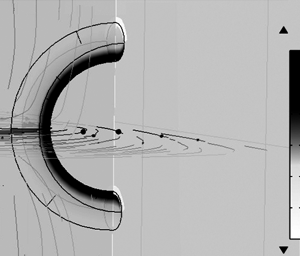Influence of single layer winding geometry of inductive element on loss resistance
DOI:
https://doi.org/10.3103/S073527272301003XAbstract
The Dowell and Ferreira calculation methods for the loss resistance of choke windings are analyzed in this paper. We determine that the neglect of the winding geometry influence is the cause of their error, because the problem is solved on a plane. The influence of winding geometrical parameters on current distribution in conductors is investigated for verification. The influence of single layer winding geometry on loss resistance for conductors of different diameters is considered. It is determined that the influence of winding geometry on the loss resistance is significant (up to 40%), and it increases with increasing conductor diameter and frequency, and decreasing coil diameter. There is non-uniformity in current distribution of coiled into a ring conductor caused by proximity effect. The influence of inter-winding distance for a single layer winding on its loss resistance is studied. The influence of interturn proximity effect is significant and increases with decreasing inter-winding distance. The reason for discrepancy with known methods is the non-uniformity of current distribution in the outer and inner turns. The peculiarities of current distribution in square cross-section conductors and equivalent in area cylindrical conductors presented as straight single conductors, single turns, and single layer windings are considered. The influence of the conductor shape on current distribution and its density are determined.
References
- C. K. Alexander, M. N. O. Sadiku, Fundamentals of Electric Circuits. New York, NY: McGraw-Hill, 2009.
- M. Kazimierczuk, High‐Frequency Magnetic Components. Wiley, 2013, doi: https://doi.org/10.1002/9781118717806.
- G. Bocock, Essential Guide to Power Supplies. [no info]: XP Power, 2014.
- C. W. T. McLyman, Transformer and Inductor Design Handbook. New York: CRC Press, 2004, doi: https://doi.org/10.1201/9780203913598.
- K. Jensen, “Liz wire: Practical design consideration for today`s high frequency application,” in Power Magnetics & High Frequency Workshop, 2020, uri: https://www.psma.com/sites/default/files/uploads/files/Litz Wire Practical Design Considerations for Todays HF Applications Jensen%2C Rubadue.pdf.
- V. I. Siforov, Radio Receiving Devices, [in Russian]. Moscow: Military Publishing House of Ministry of Defense of USSR, 1954.
- A. I. Pressman, K. Billings, T. Morey, Switching Power Supply Design. New York: McGraw-Hill Companies, 2009.
- H. Choi, “Pre-matching circuit for high-frequency ultrasound transducers,” Sensors, vol. 22, no. 22, p. 8861, 2022, doi: https://doi.org/10.3390/s22228861.
- G. Haobijam, R. P. Palathinkal, Design and Analysis of Spiral Inductors. New Delhi: Springer India, 2014, doi: https://doi.org/10.1007/978-81-322-1515-8.
- P. L. Dowell, “Effects of eddy currents in transformer windings,” Proc. Inst. Electr. Eng., vol. 113, no. 8, p. 1387, 1966, doi: https://doi.org/10.1049/piee.1966.0236.
- J. A. Ferreira, “Improved analytical modeling of conductive losses in magnetic components,” IEEE Trans. Power Electron., vol. 9, no. 1, pp. 127–131, 1994, doi: https://doi.org/10.1109/63.285503.
- H. Johnson, M. Graham, “To understand skin effect, you must first understand how eddy currents operate...,” in High Speed Signal Propagation: Advanced Black Magic, Prentice Hall, 2003, pp. 58–78.
- A. Ducluzaux, “Extra losses caused in high current conductors by skin and proximity effects,” Cahier technique, no. 83, 1983.
- А. P. Seredin, А. V. Movchaniuk, “Analysis of techniques and modification of existing expressions for calculating choke loss resistance at ultrasonic frequencies,” in Proc. of Int. Sci. Tech. Conf. on Radio Fields, Signals, Apparatus and Systems, 2020, pp. 52–55.
- X. Nan, C. R. Sullivan, “An improved calculation of proximity-effect loss in high-frequency windings of round conductors,” in IEEE 34th Annual Conference on Power Electronics Specialist, 2003. PESC ’03., 2003, vol. 2, pp. 853–860, doi: https://doi.org/10.1109/PESC.2003.1218168.
- N. Kumar, Comprehensive Physics XII. New Delhi: Laxmi Publications, 2003.
- D. W. Knight, “Practical continuous functions for the internal impedance of solid cylindrical conductors,” 2016. doi: https://doi.org/10.13140/rg.2.1.3865.1284.


